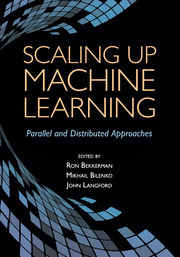11 results
Part One - Frameworks for Scaling Up Machine Learning
-
- Book:
- Scaling up Machine Learning
- Published online:
- 05 February 2012
- Print publication:
- 30 December 2011, pp 21-22
-
- Chapter
- Export citation
Preface
-
- Book:
- Scaling up Machine Learning
- Published online:
- 05 February 2012
- Print publication:
- 30 December 2011, pp xv-xvi
-
- Chapter
- Export citation
Subject Index
-
- Book:
- Scaling up Machine Learning
- Published online:
- 05 February 2012
- Print publication:
- 30 December 2011, pp 471-475
-
- Chapter
- Export citation
Part Four - Applications
-
- Book:
- Scaling up Machine Learning
- Published online:
- 05 February 2012
- Print publication:
- 30 December 2011, pp 371-372
-
- Chapter
- Export citation
Frontmatter
-
- Book:
- Scaling up Machine Learning
- Published online:
- 05 February 2012
- Print publication:
- 30 December 2011, pp i-iv
-
- Chapter
- Export citation
Part Three - Alternative Learning Settings
-
- Book:
- Scaling up Machine Learning
- Published online:
- 05 February 2012
- Print publication:
- 30 December 2011, pp 281-282
-
- Chapter
- Export citation

Scaling up Machine Learning
- Parallel and Distributed Approaches
-
- Published online:
- 05 February 2012
- Print publication:
- 30 December 2011
1 - Scaling Up Machine Learning: Introduction
-
-
- Book:
- Scaling up Machine Learning
- Published online:
- 05 February 2012
- Print publication:
- 30 December 2011, pp 1-20
-
- Chapter
- Export citation
Contributors
-
- Book:
- Scaling up Machine Learning
- Published online:
- 05 February 2012
- Print publication:
- 30 December 2011, pp xi-xiv
-
- Chapter
- Export citation
Contents
-
- Book:
- Scaling up Machine Learning
- Published online:
- 05 February 2012
- Print publication:
- 30 December 2011, pp v-x
-
- Chapter
- Export citation
Part Two - Supervised and Unsupervised Learning Algorithms
-
- Book:
- Scaling up Machine Learning
- Published online:
- 05 February 2012
- Print publication:
- 30 December 2011, pp 107-108
-
- Chapter
- Export citation



